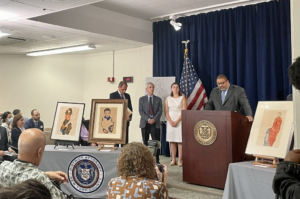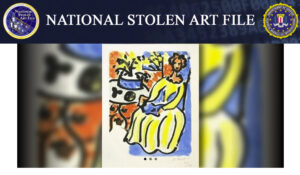 “Theft, looting, and illicit trafficking of cultural property is a crime,” states UNESCO’s Illicit Trafficking Unit. “It deprives people of their history and culture; it weakens social cohesion…and fuels organized crime and terrorism.” UNESCO, one of the most powerful organizations in the looted art battle, reports that it has fought to protect cultural heritage since 1970.
“Theft, looting, and illicit trafficking of cultural property is a crime,” states UNESCO’s Illicit Trafficking Unit. “It deprives people of their history and culture; it weakens social cohesion…and fuels organized crime and terrorism.” UNESCO, one of the most powerful organizations in the looted art battle, reports that it has fought to protect cultural heritage since 1970.
Two benchmark achievements this year of the UNESCO Illicit Trafficking Unit: Australia returned art to Mexico and they lit a spotlight on Afghan’s trafficked antiquities. UNESCO’s website lists nationally important stolen and lost objects. They ask for your help in locating eighty pre-Columbian Chilean gold artifacts, five objects from a church in Puebla, Mexico, works from El Salvador, Guatemala, Greece, and Peru. Assist in recovering objects stolen from private homes and museums, from Burkina Faso, and Bolivia, and France, even an important nuclear document stolen from Ecuador.
If you experienced a theft of a work of art or lost an antiquity
 Organizations besides local law enforcement can help. Here a checklist:
Organizations besides local law enforcement can help. Here a checklist:
- Register a stolen object on the Interpol Stolen Works of Art database
- Register American stolen or looted art on the US National Stolen Art File (NSAF) in the FBI’s database
If you’re interested in laws around stolen or looted art both in the US and abroad, I recommend:
- UNESCO’s database of Cultural Heritage Laws
- SHERLOC, a database from the United Nation’s Office on Drugs and Crime for electronic resources and laws on crime (legislation pending and case law as well as a directory of national and international crime authorities)
- The International Counsel of Museum’s Red List database; a visual guide of the objects MOST VUNERABLE to theft and illicit trafficking in museums worldwide.
Manhattan DA’s Antiquities Trafficking Unit
Another important and powerful team charged with the prevention and recovery of looted works of art is the Manhattan District Attorney’s Antiquities Trafficking Unit, formed under former DA Cyrus Vance, Jr. in 2017. Since then the Unit has recovered more than 4,500 stolen antiquities, with a combined value of over $410 million, from thirty countries. They don’t just cover New York’s crime and civil cases. They follow works of art trafficked through New York.
 Let me tell you a story about the sleuthing, personal tenacity, and ongoing legislation around looted works of watercolors/drawings by Austrian artist Egon Schiele (1890-1918). The Manhattan District Attorney’s Antiquities Trafficking Unit under DA Alvin Bragg investigated the case. Last month the antiquities trafficking unit issued warrants to three out of state museums that owned works by Schiele: the Art Institute of Chicago, the Carnegie Museum of Pittsburgh, and Oberlin College’s Allen Art Museum. Connoisseur Fritz Grunbaum, an Austrian cabaret performer, owned the works previously. Officials allegedly forced him to sign a power of attorney while held at Dachau concentration camp in 1938. This permitted Grunbaum’s wife to liquidate her husband’s large art collection to the Nazi regime. During his lifetime Grunbaum amassed an impressive collection of Austrian art, including some eighty-pieces by Schiele. Nazis killed both husband and wife in separate concentration camps in the early 1940s.
Let me tell you a story about the sleuthing, personal tenacity, and ongoing legislation around looted works of watercolors/drawings by Austrian artist Egon Schiele (1890-1918). The Manhattan District Attorney’s Antiquities Trafficking Unit under DA Alvin Bragg investigated the case. Last month the antiquities trafficking unit issued warrants to three out of state museums that owned works by Schiele: the Art Institute of Chicago, the Carnegie Museum of Pittsburgh, and Oberlin College’s Allen Art Museum. Connoisseur Fritz Grunbaum, an Austrian cabaret performer, owned the works previously. Officials allegedly forced him to sign a power of attorney while held at Dachau concentration camp in 1938. This permitted Grunbaum’s wife to liquidate her husband’s large art collection to the Nazi regime. During his lifetime Grunbaum amassed an impressive collection of Austrian art, including some eighty-pieces by Schiele. Nazis killed both husband and wife in separate concentration camps in the early 1940s.
Grunbaum’s heirs/descendants have fought since 2005 to reclaim artworks owned by their relatives. The 2016 passing of the Holocaust Expropriated Recovery Act extended the statute of limitations and aided this fight.
Local Tie-In
 The Santa Barbara Museum of Art became involved in the reclamation case regarding Nazi-looted art brought by Grunbaum’s heirs (covered at the time by Art Net News, 12/21/2022). The story comes with an honorable ending, however. On September 20, 2023, seven works of art were handed over to Grunbaum’s heirs in an event organized by the Manhattan DA’s office. Our SBMA previously held one work in their collection. Three organizations, MOMA, the Morgan Library & Museum, and SBMA, voluntarily relinquished four of the seven pieces. Individual collectors privately abdicated ownership to three other works. Art Net News reports that proceeds from the sale of the works will benefit a charity established by Grunbaum’s heirs.
The Santa Barbara Museum of Art became involved in the reclamation case regarding Nazi-looted art brought by Grunbaum’s heirs (covered at the time by Art Net News, 12/21/2022). The story comes with an honorable ending, however. On September 20, 2023, seven works of art were handed over to Grunbaum’s heirs in an event organized by the Manhattan DA’s office. Our SBMA previously held one work in their collection. Three organizations, MOMA, the Morgan Library & Museum, and SBMA, voluntarily relinquished four of the seven pieces. Individual collectors privately abdicated ownership to three other works. Art Net News reports that proceeds from the sale of the works will benefit a charity established by Grunbaum’s heirs.
At the transference ceremony in Manhattan last month, DA Alvin Bragg stated: “Fritz Grunbaum was a man of incredible depth and spirit, and his memory lives on through the artworks that are finally being returned to his relatives. I hope this moment can serve as a reminder that despite the horrific death and destruction caused by the Nazis, it’s never too late to recover some of what we lost, honor the victims, and reflect on how their families are still impacted today.” Art Net News states this transfer could have major implications for cases involving looted art.